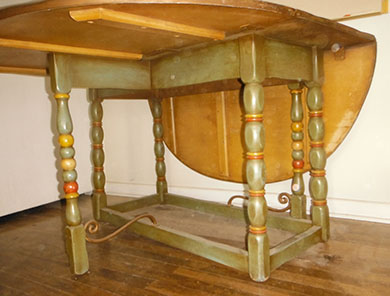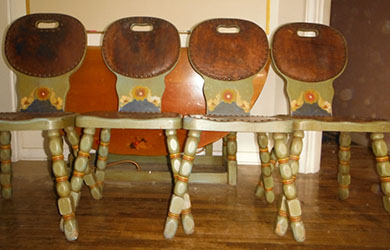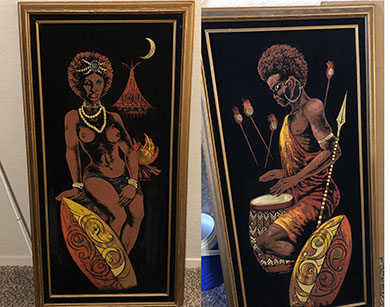 |
|
|||
 |
 |
|||
RINKER ON COLLECTIBLES — Column #1713 Copyright © Harry Rinker, LLC 2019 Questions
and Answers
QUESTION: I have a Monterey furniture blue painted, gateleg table and set of four matching chairs. The table has a Monterey brand and is marked “798 / BLUE & DEC.” From what I found online, it appears the table and chairs are very desirable. I would like to sell the set. What can you tell me about my table and chairs and how do I best to go about selling them? –CG, Tyler, TX, Email Question 
ANSWER: Monterey furniture is not a furniture company but a generic name for furniture made in Colonial, Dutch, and Spanish styles by a variety of California furniture makers including Brown, and Saltman, Delray, the Imperial Furniture Company (Coronado line), Mason Manufacturing Company, Sears (La Fiesta), and Stickley. Mason Manufacturing Company, founded by Frank Mason and his son George, is credited with originating the style. Monterey furniture dates from the 1930s to the mid-1940s. Mason Monterey furniture is generally made of Oregon alder. During the classic period from 1930 to 1932, the furniture was painted with a lively-Mexican palette that was toned down with an asphaltum glaze to create an antique appearance. Often pieces were colorfully decorated with a Mexican motif. Mason branded most of its furniture with a mark featuring a horseshoe with “Monterey” running through it. The company produced furniture for 14 years. Near the end of production, the furniture had more of a Colonial Revival rather than Spanish appearance. Your gateleg table mimics the Colonial Revival style. The chairs have more a Dutch/Spanish style. The brightly colored painted rings separating the bulbous turnings of the legs suggest a Mexican influence. Monterey furniture is highly collectible, especially in California and the Southwest states. It is featured at a number of national parks and monuments including Carter Lake National Park and Oregon Caves National Monument. Judging from the images accompanying your email, the table and chairs appear to be in very good or better condition. A fair secondary retail market value for the set is between $900.00 and $1,100.00. These are replacement values. Expect to get less when you sell the set. The are many options for selling your furniture. The first is at auction. Possibilities are Heritage Auctions in Dallas, TX, Los Angeles Modern Auctions, or Julien’s in Los Angeles. Bonham & Butterfield, Christie’s, Freeman’s, and Heritage also have offices in Los Angeles. A second option is to sell to a dealer. A dealer needs to make a profit so be prepared to discount the retail price by at least 50 percent. In researching Monterey furniture on the internet, I came across a website for The Bungalow Store (2317 India Street, San Diego, CA 92101 / (619) 234-7383). The firm appears to have great success in selling Monterey furniture. Ideally, it would be best to find a local buyer, thus avoiding moving costs. Check with your local historical society or museum to see if they can help you find a collector or collectors in your area. 
QUESTION: I have a Kalamazoo Sled Company Champion Snow Liner, Model #114 sled. I acquired it 20 years ago at a silent auction. I paid $100.00. The sled is in excellent condition. What is it worth? – TL, Kalamazoo, MI, Email Question ANSWER: The Page Manufacturing Company, located on the corner of Third and Sheraton in Kalamazoo, Michigan, was founded in the 1870s. The company manufactured wood parts for horse-drawn buggies. Through a reorganization, the Page Manufacturing Company became the Kalamazoo Sled Company on February 14, 1894. The Kalamazoo Sled Company acquired the Columbia Sled Company. It employed more than 100 workers at its peak and billed itself as the “largest manufacturer of children’s sleds in the world.” Because sled production was a seasonal business, the Kalamazoo Sled Company made a variety of other objects in the off season—croquet sets, lawn furnishings, and wooden handles for feather dusters. Kalamazoo produced a wide range of sleds in a variety of styles aimed at the youth and adult markets. The sleek, low racing models were extremely popular with boys. Girls preferred the ornate, high-sided models. The Kalamazoo Sled Company used several different logos. The most common was a circle with a double border. Inside the border is “KALAMAZOO SLED COMPANY” in an arch at the top and “KALAMAZOO, MICHIGAN” in a reverse arch on the bottom. The center consists of a green ground on which is a red “K.” When it appears on a Champion sled it rests inside a quarter circle frame that rests on a base with downward slopping edges. Inside the base is “CHAMPION.” [For a more detailed history of the company, see: https://www.kpl.gov/local-history/kalamazoo-history/business/kalamazoo-sled-company/.] The Champion sled was Kalamazoo’s most popular model. It was remolded and updated continuously. The basic model type you have is “Sno-Liner” and not “Snow Liner,” which explains why I had trouble researching the sled. I was unable to find any examples of the Champion Sno-Liner Model 114. I did find several examples of the Sno-Liner Model 110, a four-foot model. My guess is that your sled follows the same design but is larger. The Sno-Liner series had a streamlined appearance. The design featured a wing-like brace in front of a similarly designed steering mechanism. The listings for the Model 110 indicated the sled was made in the 1950s. What is your sled worth? The answer is $100.00 at the time you bought it. When bidding at a silent auction, especially if it is a fund-raising auction, the heart trumps the head on most occasions. You paid more than the sled was worth at the time. The same holds true today. The good news is the sled is in the region where it was made. Local collectors do pay a premium for local material. A viable secondary market value for the sled, assuming it is in excellent condition, is between $65.00 and $85.00 in the Kalamazoo area. Anywhere else, the value range is $40.00 to $50.00. QUESTION: I have a matching pair of black velvet paintings. One features a seated naked female warrior with a shield resting beside her leg. The background has a castle tower and a crescent moon. The other is a seated, robed African male beating a drum with his hands. His shield and spear rest beside his left leg. They are vertical in approach and quite large. There is no signature. I am curious about the worth of these paintings? –JA, E-mail Question 
ANSWER: Historically, painting on black velvet originated in the Kashimar. The images were primarily religious. In the 1970s, paintings on velvet became a kitsch fad in America. They were sold at road side stands and service stations. Known among collectors as the Velvet Elvis craze, the images covered a wide range of topics—animals, clowns, cowboys, dogs playing poker, Jesus and other religious themes, landscapes, Native Americans, personalities such as Dale Earnhardt, J. F. K, and John Wayne, wolves, and, of course, avant-garde and exotic (or perhaps more correctly erotic) themes. Most of the 1970s velvet paintings came from Ciudad Juárez, Mexico. Doyle Harden, a Georgia ex-patriot, established a factory there. Over 1,000 artists cranked out velvet paintings on an assembly line basis. Each artist specialized. As one artist finished painting his section, the painting was passed along to the next specialist until the painting was completed. Pseudo names were signed to many of the pieces. The Velveteria Epicenter of Art Fighting Cultural Deprivation, initially located in Portland, Oregon, reopened in Chinatown, Los Angeles in 2013. It is the only museum devoted exclusively to velvet paintings. Your pair of paintings have two values. In a big city/urban market where kitsch is popular, the pair has a secondary retail market value between $75.00 and $95.00. In the countryside, value drops to between $35.00 and $45.00. OBSERVATIONS FROM THE FIELD: A READER’S REPORT: I want to share an August 28, 2019, email I received from Dick and Ramona Wise. It reads: “A note on the changing antiques scene here in the heartland. “There is a small mall about an hour’s drive away from our home in Charleston [IL} where we stop several times a year. We have watched as they have struggled to keep going as their customer base shrinks, dealers dwindle, and merchandise changes from old stuff to more and more new decorative items off the boat from China. “We stopped last week and saw a new wrinkle. The mall now provides grocery-style, wheeled shopping carts. The response from the customers has been unexpected but telling. The customers do not fill up the carts with merchandise. Rather, they lean heavily on them for support as they geriatrically [sic.] shuffle up and down the aisles.” Harry L. Rinker welcomes questions from readers about
collectibles, those mass-produced items from the twentieth and twenty-first centuries.
Selected letters will be answered in this column.
Harry cannot provide personal answers.
Photos and other material submitted cannot be
returned.
Send your questions to: Rinker on Collectibles, 5955 Mill
Point Court SE, Kentwood, MI 49512.
You also can e-mail your questions to
harrylrinker@aol.com.
Only e-mails containing a full name and mailing address
will be considered.
|
||||